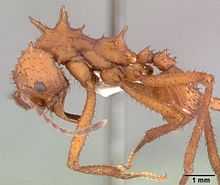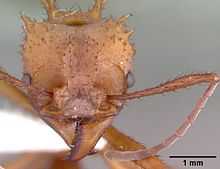Acromyrmex octospinosus
| Acromyrmex octospinosus | |
|---|---|
 | |
| Worker Acromyrmex octospinosus carrying a leaf | |
| Scientific classification | |
| Kingdom: | Animalia |
| Phylum: | Arthropoda |
| Class: | Insecta |
| Order: | Hymenoptera |
| Family: | Formicidae |
| Subfamily: | Myrmicinae |
| Tribe: | Attini |
| Genus: | Acromyrmex |
| Species: | A. octospinosus |
| Binomial name | |
| Acromyrmex octospinosus Reich 1793 | |
Acromyrmex octospinosus is a species of New World ants of the subfamily Myrmicinae of the genus Acromyrmex. It is found in the wild naturally in Central America ranging from southern Mexico down to Panama; and across northern South America in Venezuela.
Overview

Commonly known as "leaf-cutter ants" they are a species of ant from one of the two genera of advanced attines within the tribe Attini.
Acromyrmex can be identified from the closely related Atta genus of leafcutter ants since they have 4 pairs of spines and a rough exoskeleton on the upper surface of the thorax.
A mature Acromyrmex octospinosus colony has a relatively small colony size of approximately 50,000 ants, mostly sterile female workers. They are divided into castes, based mostly on size, that perform different functions. Acromyrmex exhibit a high degree of biological polymorphism, four castes being present in established colonies - minims (or "garden ants"), minors, mediae and majors. Majors are also known as soldiers or dinergates. Each caste has a specific function within the colony. Acromyrmex ants are less polymorphic than the other genera of leafcutter ants Atta, meaning that there is comparatively less differential in size from the smallest to largest types of Acromymex. The high degree of polymorphism in this genus is also suggestive of its high degree of advancement.
It takes around 18 months for the colony to reach maturity but the queen of Acromyrmex octospinosus colony lives for 10 to 12 years and lays around 600 eggs per day at her peak.
Like Atta, Acromyrmex subsists mostly on a particular species of fungus (genus Leucocoprinus) which it cultivates on a medium of masticated leaf tissue. This is the sole food of the queen and other colony members that remain in the nest. The media workers also gain subsistence from plant sap they ingest whilst physically cutting out sections of leaf from a variety of plants.

Before leaving their parent colonies, winged females take a small section of fungus into their bucchal pouches and it is with this that the subsequently wingless queens 'seed' the fungus gardens of incipient colonies, cutting and collecting the first few sections of leaf themselves.
Acromyrmex has evolved to change foodplant constantly, preventing a colony from completely stripping off leaves and thereby killing trees, thus avoiding negative biological feedback on account of their sheer numbers. However, this does not diminish the huge quantities of foliage they harvest and the amount of foliage they strip means they have become agricultural pests on the various Caribbean islands they have been introduced on, such as Guadeloupe.
Foundresses of the leaf-cutting ant Acromyrmex octospinosus forage for leaves as garden substrate (semi-claustral foundation). The fungal pellet and substrate usually are attached to rootlets, which are used as a platform for the garden. This arrangement keeps the garden suspended away from the earthen chamber of the underground nest during early colony growth, and it serves to minimize contact between the garden and contaminants. A. octospinosus foundresses produce from 3 to 7 workers in 2.7 months after founding the nest, but workers do not forage for substrate at this time. Incipient nests died or were abandoned at a monthly rate of about 50%. The ants routinely clean their legs before manipulating the garden substrate. The foundresses use their fore-legs to rub the surface of the metapleural gland, and they then use typical grooming behaviors to pass the forelegs through the mouthparts, after which the ant then licks the garden substrate. Similarly, ants apparently use their mouths to transfer fecal droplets to their legs. These grooming behaviors are prophylactic behaviors that may help the foundress maintain a hygienic garden.
Subspecies
The species Acromyrmex octospinosus contains the following subspecies
- Acromyrmex octospinosus cubanus Wheeler, 1937
- Acromyrmex octospinosus echinatior Forel, 1899
- Acromyrmex octospinosus ekchuah Wheeler, 1937
- Acromyrmex octospinosus inti Wheeler, 1937
- Acromyrmex octospinosus octospinosus Reich, 1793
- Acromyrmex octospinosus volcanus Wheeler, 1937
Synonyms
References
- Fernandez-Marin, H., J. K. Zimmermann, and W. T. Wcislo (2003) Nest-founding in Acromyrmex octospinosus (Hymenoptera, Formicidae, Attini): demography and putative prophylactic behaviors. Insectes Sociaux 50:304-308.
- Schultz, T. R., D. Bekkevold, and J. J. Boomsma (1998) Acromyrmex insinuator new species: an incipient social parasite of fungus-growing ants. Insectes Sociaux 45:457-471.
- Wetterer, J. K. (1991) Foraging ecology of the leaf-cutting ant Acromyrmex octospinosus in a Costa Rican rain forest. Psyche 98:361-371.
External links
 Media related to Acromyrmex octospinosus at Wikimedia Commons
Media related to Acromyrmex octospinosus at Wikimedia Commons